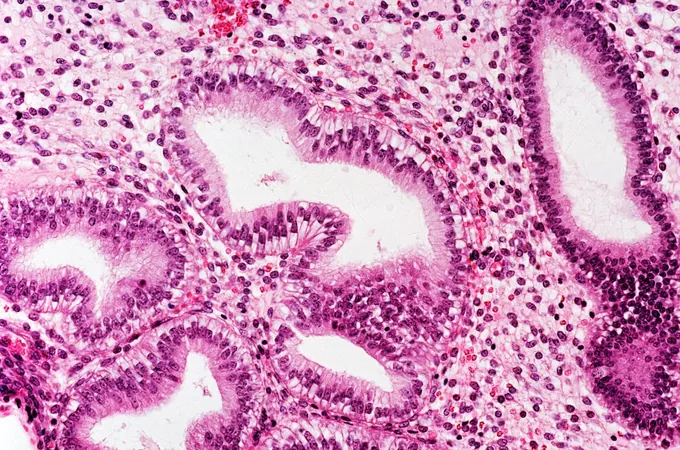
Unveiling a Revolutionary Endometrial Map: The Key to Unlocking Endometriosis Treatments?
2024-09-19
Introduction
In an extraordinary breakthrough, an international team of scientists has unveiled the most comprehensive cellular map of the endometrium to date. This inner layer of tissue lining the uterus has remained a mystery for years, contributing to the struggles faced by more than 190 million women worldwide suffering from endometriosis. This groundbreaking research, published in the prestigious journal Nature Genetics, utilizes advanced molecular biology techniques and cutting-edge machine learning to pave the way for potential future therapies.
The Legacy of Neglect
Roser Vento-Tormo, 37, a researcher at the Wellcome Sanger Institute in the UK, co-authored this pivotal study. She highlights the historical neglect of endometrial research, largely due to insufficient funding directed toward women's health issues. Furthermore, the endometrium's ever-changing nature—regenerating entirely each month—presents a significant challenge for scientific study. "The endometrium adapts and transforms every five days," Vento-Tormo explains, making it one of the most complex systems in the human body.
Understanding the Endometrial Cycle
During the menstrual cycle, the endometrium thickens in preparation for possible pregnancy, only to be shed if conception does not occur. This intricate process involves millions of cells adjusting their identities and functions in response to fluctuating hormones, leading to a complex interplay that has been difficult for researchers to unravel.
The Revolutionary Endometrial Map
The newly developed map acts as a "Google Maps" for the endometrium, allowing scientists to pinpoint the location and composition of each cell and understand its interactions. This was achieved through single-cell sequencing, which analyzes genetic material at the individual cell level. "Think of it as a passport for each cell, revealing its identity and potential when interacting with others," Vento-Tormo illustrates.
Implications for Endometriosis Research
This innovative tool holds immense potential for studying endometriosis, a condition where endometrial cells migrate outside the uterus, causing debilitating pain and infertility. In their research, scientists examined over 313,000 endometrial cells from 63 reproductive-aged individuals, including 30 with endometriosis. This extensive analysis aims to shed light on the disease's complexities, which currently lack effective treatments beyond symptom management.
A Major Step Forward in Women's Health
The establishment of a shared vocabulary to integrate existing and future data marks a significant advancement in the understanding of the female reproductive system. Estela Lorenzo, a specialist in the Endometriosis Unit at Hospital 12 de Octubre in Madrid, emphasizes that foundational studies like this are crucial for advancing women's health. "This research connects previously isolated knowledge and is a vital step toward a medical revolution in women’s wellness," she asserts.
Expert Opinions
Francisco Carmona, a seasoned gynecologist with decades of experience in endometriosis research, expresses optimism regarding the map's potential impact on clinical practice. "While this research may seem distant now, it has the potential to generate invaluable knowledge in the future," he remarks. The endometrium has long been a "puzzle of ten thousand pieces" for practitioners. With this map, medical professionals now have a standardized model to work from, enhancing their understanding of this complex tissue.
Future Research Directions
Looking ahead, researchers plan to expand their patient sample to refine the map and explore the nuances of endometrial function further. They aim to identify how various cell types support or hinder the endometrium's proper functioning—a critical factor, as recent findings indicate that microenvironmental cells may play a more pivotal role in endometriosis than previously thought.
Alignment with Global Initiatives
This endometrium map aligns with the Human Cell Atlas initiative, an ambitious global project striving to chart every cell type in the human body. Successfully mapping the endometrium could provide a foundation for diagnosing and treating a wide range of conditions with previously obscure treatments.
Conclusion: A Beacon of Hope
In an era where knowledge can translate into life-changing therapies, this unprecedented cellular exploration harbors hope for millions affected by endometriosis and heralds a new age in women's health research. Will this map be the key to unlocking better treatments for endometriosis? Only time will tell!






 Brasil (PT)
Brasil (PT)
 Canada (EN)
Canada (EN)
 Chile (ES)
Chile (ES)
 España (ES)
España (ES)
 France (FR)
France (FR)
 Hong Kong (EN)
Hong Kong (EN)
 Italia (IT)
Italia (IT)
 日本 (JA)
日本 (JA)
 Magyarország (HU)
Magyarország (HU)
 Norge (NO)
Norge (NO)
 Polska (PL)
Polska (PL)
 Schweiz (DE)
Schweiz (DE)
 Singapore (EN)
Singapore (EN)
 Sverige (SV)
Sverige (SV)
 Suomi (FI)
Suomi (FI)
 Türkiye (TR)
Türkiye (TR)